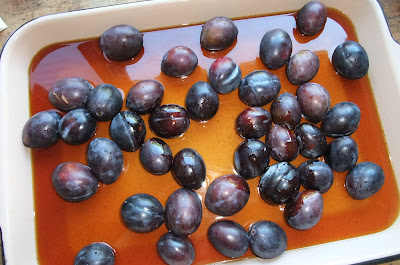2 Tablespoons Lemon Juice
2 Fresh Jalapenos (diced) included seeds for spicier Butter
1 Cup Honey
2 Cups Sugar
DIRECTIONS
This can either be a one or two day process. If you start early in the morning, you can work on this butter throughout the day while you get other chores done around the house. You can also start cooking down the sauce, remove from the stove top and let it cool, than continue to cook the next day, or you can even slow cook using your oven. Read the directions all the way through and see what will work best for your schedule.
Use a large heavy bottom pan that can be used in the oven and on the stove top, add splash of hard cider, cider or apple juice.
Take 5 pears, wash, cut off stem and blossom end. Cut into small pieces. Add to pan with cider. Heat on medium low, stirring occasionally, until fruit is soft.
Run fruit through a Food Mill using a fine screen. Return to pan.
Add honey, sugar and diced ginger. Cook over low heat stirring regularly until sauce begins to thicken. You are going to want your sauce to reduce by half at the very least. This can take 4 to 6 hours. Here is where you can set your oven to 250 degrees and reduce overnight, or throughout the day stirring occasionally. The point is to have intense flavor in a thick fruit butter.
When your butter has reached the desired consistency, process your jalapenos. Jalapeno peppers add heat and flavour, but if you are cooking with them, you need to exercise some caution. It is best to wear a pair of gloves when handling the jalapenos.
Once you have washed the jalapenos, use a sharp knife to split them open and scrape out the seeds . Then mince them in a mini food processor or coffee grinder. Add to your pear butter. Let it simmer for about 15 minutes. Taste and adjust honey and or sugar if you like. Let simmer for another half-hour, to an hour to let the flavors meld.
Now you are going to want to get your canning jars sterilized. The dishwasher is great for this. If you don't have a dishwasher you can wash the containers in hot, soapy water and rinse, then sanitize the jars by boiling them 10 minutes. Keep the jars in hot water until they are used or leave the jars in the dishwasher on "heated dry" until ready to use. Keeping them hot will prevent the jars from breaking when you fill them with the hot pear butter.
Put the lids into a pan of hot, but not quite boiling water (that's what the manufacturer's recommend) for 5 minutes, and use the magnetic "lid lifter wand" to pull them out.
Fill them to within 1/4 inch of the top, wipe any spilled pear butter off the rim, seat the lid, and finger tighten the ring around them.
Put them in the Hot Water Bath and boil pint jars for 5 minutes and quart jars for 10 minutes.
Put them in the Hot Water Bath and boil pint jars for 5 minutes and quart jars for 10 minutes.
If you would like to do a Pear Butter that is not spicy, follow the same recipe removing the jalapenos. Halve the amount of honey and sugar and then adjust for flavor accordingly. Use crystallized ginger instead of fresh, and add 1/2 teaspoon of allspice and 1/2 teaspoon nutmeg.
There you have it, a little bit of heaven in a jar!






















